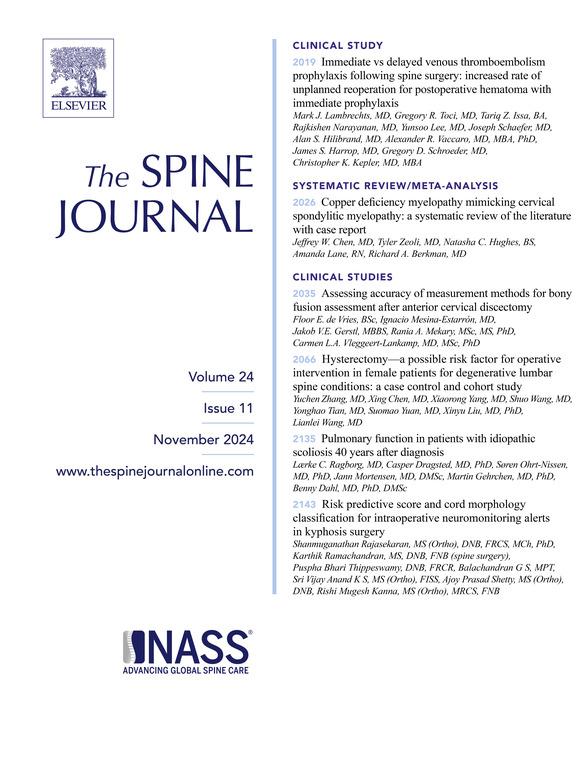69. Is successful closed skeletal traction prior to surgery for patients with traumatic locked facet of subaxial cervical spine associated with superior neurologic improvement?
IF 4.7
1区 医学
Q1 CLINICAL NEUROLOGY
引用次数: 0
Abstract
BACKGROUND CONTEXT
Traumatic locked facet in the subaxial cervical spine can be treated with closed skeletal traction (CST) prior to definitive surgery. Comparison of neurologic outcomes among patients with successful CST versus unsuccessful or no attempted CST prior to surgery are lacking.
PURPOSE
We aimed to determine whether successful CST prior to definitive surgery for patients with traumatic locked facet of subaxial cervical spine is associated with superior neurologic improvement.
STUDY DESIGN/SETTING
This was a single-center retrospective study of patients treated at an apex Level I trauma center in the United States.
PATIENT SAMPLE
Consecutive patients with traumatic locked facet in the subaxial cervical spine presenting to the trauma center during during 2008-2022 were included. Patients with less than 90-day follow-up and those with cervical spine injuries other than de facto locked facet (unilateral or bilateral) were excluded.
OUTCOME MEASURES
The primary study outcome was improvement in ASIA motor score (AMS), assessed after 3 months.
METHODS
Socio-demographic, clinical, and procedural variables were extracted and analyzed using descriptive and inferential statistics, including multivariable regression analyses, in StataBE 17. Univariate associations and clinical expertise were jointly utilized for multivariable model selection, with Akaike information criterion (AIC) used to assess model fit. Violin, deviation, waterfall, and coefficient plots were used for visualization.
RESULTS
A total of 67 patients were included, with a median age of 51 years (interquartile range [IQR]) 31-64). 21 (31%) patients were female, and locked facet was bilateral in 39% (N=26). Mechanism was high-energy trauma (motor vehicle collision or fall from height) in 67% (N=42). Modified 5-factor frailty index (MFI-5) score was 0 in 69%, 1 in 21%, and 2 or greater in 10%. At admission, ASIA impairment scale (AIS) grades were A, B, C, and D in 36%, 13%, 9%, and 42%, respectively, and median ASIA motor score was 38 (IQR 15-94). CST was attempted in 55 patients (82%), being successful in 60% of those (n=33) patients. Intramedullary lesion length (IMLL) was 29.05 mm (IQR 11.4-42.6) at admission and 39 (IQR 18.15-60.05) postoperatively. IMLL and ASIA score were found collinear. At 3-month follow-up, AIS grades were A, B, C, D, and E in 16.4%, 17.9%, 6%, 43.3%, and 16.4%, respectively and median AMS was 94 (IQR 30-100). Median improvement in AMS was 11 (IQR 3-33). Based on previously reported minimum clinically important difference (MCID) improvement in AMS of ³6, 69% (n=46) had improved by 3-months. In a multivariable logistic regression for MCID ASIA change, with covariates of admission IMLL, MFI-5, successful CST, and age categories, only admission IMLL had a significant association, with odds ratio 1.03 (P-value=0.04). These findings remained the same upon replacing 'successful CST' with 'receipt of any CST' as covariate.
CONCLUSIONS
Admission IMLL predicted AMS improvement at 3-month follow-up in traumatic cervical locked facet patients, irrespective of whether CST was performed and whether it was successful.
FDA Device/Drug Status
This abstract does not discuss or include any applicable devices or drugs.
69. 手术前成功的闭合性骨牵引治疗外伤性下颈椎关节面锁定患者与上神经系统改善相关吗?
背景背景:颈椎下轴突外伤性关节面锁定可在确定手术前采用闭式骨牵引(CST)治疗。CST手术成功与未成功或未尝试CST手术患者的神经系统预后比较缺乏。目的:我们旨在确定外伤性颈椎下突关节面锁定患者在最终手术前成功的CST是否与上位神经系统改善有关。研究设计/背景:这是一项单中心回顾性研究,研究对象是在美国一家顶级I级创伤中心接受治疗的患者。患者样本包括2008-2022年期间到创伤中心就诊的连续颈椎下轴突外伤性锁定的患者。随访时间少于90天的患者和除事实上锁定的关节面(单侧或双侧)以外的颈椎损伤患者被排除在外。主要研究结果是3个月后评估的亚洲运动评分(AMS)的改善。方法在StataBE 17中提取社会人口统计学、临床和程序变量,并使用描述性和推断性统计(包括多变量回归分析)进行分析。采用单变量关联和临床专业知识联合进行多变量模型选择,采用赤池信息准则(Akaike information criterion, AIC)评估模型拟合。采用小提琴图、偏差图、瀑布图和系数图进行可视化。结果共纳入67例患者,中位年龄51岁(四分位数范围[IQR]) 31-64岁。女性21例(31%),双侧侧关节突锁定39%(26例)。67% (N=42)为高能外伤(机动车碰撞或高空坠落)。修正五因素衰弱指数(MFI-5)评分为0分的占69%,1分的占21%,2分及以上的占10%。入院时,ASIA损伤量表(AIS)评分为A、B、C、D的比例分别为36%、13%、9%和42%,ASIA运动评分中位数为38分(IQR 15-94)。55例(82%)患者尝试CST,其中60% (n=33)患者成功。髓内病变长度(IMLL)入院时为29.05 mm (IQR 11.4 ~ 42.6),术后为39 mm (IQR 18.15 ~ 60.05)。IMLL与ASIA评分共线。在3个月的随访中,AIS等级分别为A、B、C、D和E,分别为16.4%、17.9%、6%、43.3%和16.4%,中位AMS为94 (IQR 30-100)。AMS的中位改善为11 (IQR 3-33)。根据先前报道的AMS的最小临床重要差异(MCID)改善为3.6,69% (n=46)的患者在3个月内得到改善。在mcd ASIA变化的多变量logistic回归中,包括入院时IMLL、MFI-5、成功CST和年龄类别的协变量,只有入院时IMLL有显著相关,比值比为1.03 (p值=0.04)。将“成功的CST”替换为“收到任何CST”作为协变量后,这些发现仍然相同。结论:无论是否行CST或CST是否成功,IMLL均可预测外伤性颈椎关节突锁定患者在随访3个月后AMS的改善。FDA器械/药物状态本摘要不讨论或包括任何适用的器械或药物。
本文章由计算机程序翻译,如有差异,请以英文原文为准。
求助全文
约1分钟内获得全文
求助全文
来源期刊

Spine Journal
医学-临床神经学
CiteScore
8.20
自引率
6.70%
发文量
680
审稿时长
13.1 weeks
期刊介绍:
The Spine Journal, the official journal of the North American Spine Society, is an international and multidisciplinary journal that publishes original, peer-reviewed articles on research and treatment related to the spine and spine care, including basic science and clinical investigations. It is a condition of publication that manuscripts submitted to The Spine Journal have not been published, and will not be simultaneously submitted or published elsewhere. The Spine Journal also publishes major reviews of specific topics by acknowledged authorities, technical notes, teaching editorials, and other special features, Letters to the Editor-in-Chief are encouraged.
 求助内容:
求助内容: 应助结果提醒方式:
应助结果提醒方式:


